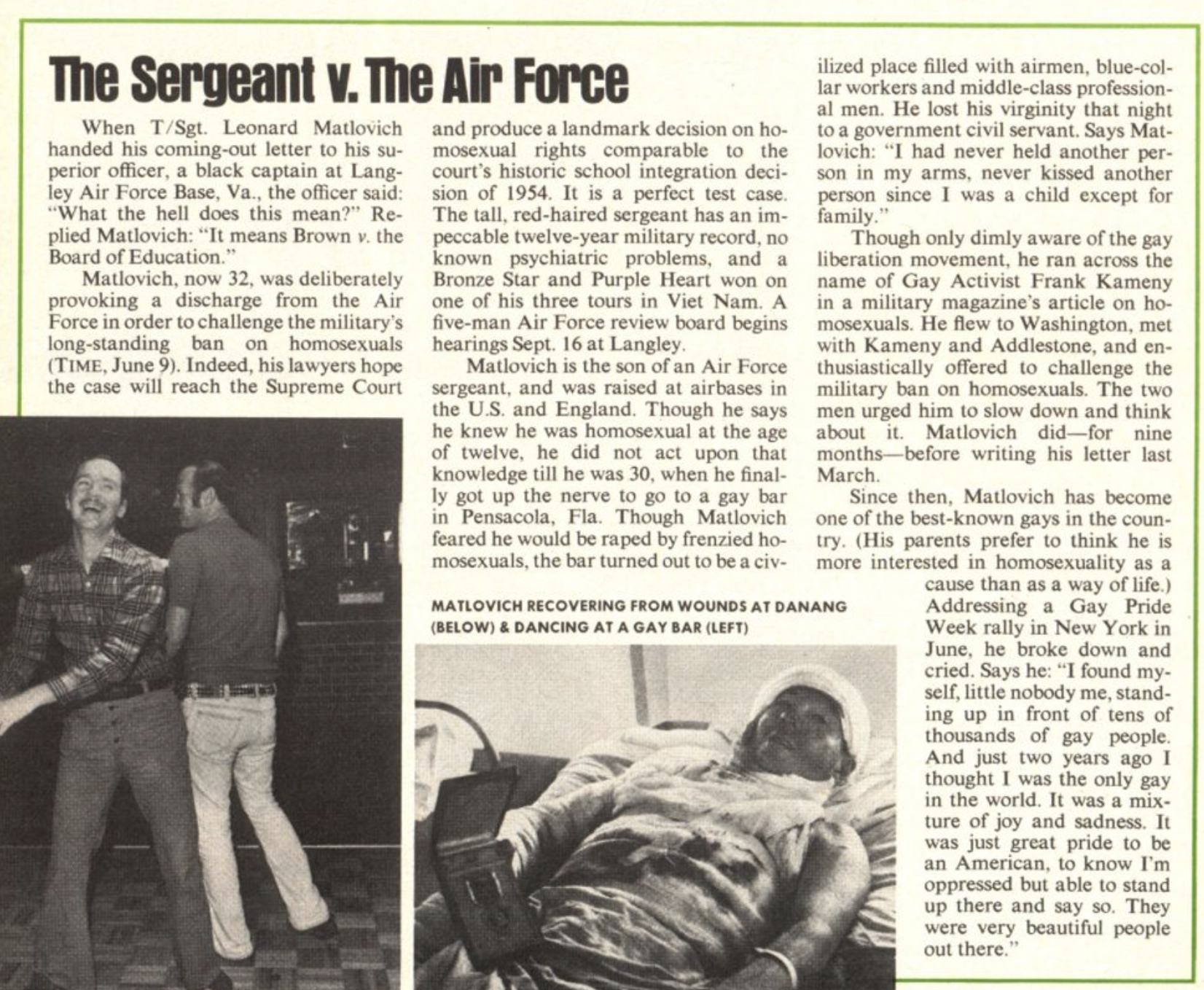Time Magazine features Leonard Matlovich, gay decorated Air Force veteran and Latter-day Saint.
- Type
- Periodical
- Source
- Time Magazine Non-LDS
- Hearsay
- DirectJournalism
- Reference
"Gays on the March", Time Magazine, September 8, 1975, 32
- Scribe/Publisher
- Time Magazine
- Audience
- Reading Public
- Transcription
The Sergeant v. The Air Force
When T/Sgt. Leonard Matlovich handed his coming-out letter to his superior officer, a black captain at Langley Air Force Base, Va., the officer said: “What the hell does this mean?” Replied Matlovich: “It means Brown v. the Board of Education.”
Matlovich, now 32, was deliberately provoking a discharge from the Air Force in order to challenge the military's long-standing ban on homosexuals (TIME, June 9). Indeed, his lawyers hope the case will reach the Supreme Court and produce a landmark decision on ho-mosexual rights comparable to the court's historic school integration deci-sion of 1954. It is a perfect test case. The tall, red-haired sergeant has an im-peccable twelve-year military record, no known psychiatric problems, and a Bronze Star and Purple Heart won on one of his three tours in Viet Nam. A five-man Air Force review board begins hearings Sept. 16 at Langley.
Matlovich is the son of an Air Force sergeant, and was raised England. Though he says he knew he was homosexual at the age of twelve, he did not act upon that knowledge till he was 30. When he final-ly got up the nerve to go to a gay bar in Pensacola, Fla. Though Matlovich feared he would be raped by frenzied ho-mosexuals, the bar turned out to be a civ-
MATLOVICH RECOVERING FROM WOUNDS AT DANANG
(BELOW) & DANCING AT A GAY BAR (LEFT)
ilized place filled with airmen, blue-col- lar workers and middle-class profession- al men. He lost his virginity that night to a government civil servant. Says Mat-lovich: “I had never held another per-son in my arms, never kissed another person since I was a child except for family.”
Though only dimly aware of the gay liberation movement, he ran across the name of Gay Activist Frank Kameny in a military magazine's article on ho-mosexuals. He flew to Washington, met with Kameny and Addlestone, and en-thusiastically offered to challenge the military ban on homosexuals. The two men urged him to slow down and think about it. Matlovich did—for nine months—before writing his letter last March.
Since then, Matlovich has become one of the best-known gays in the coun-try. (His parents prefer to think he is more interested in homosexuality as a cause than as a way of life.) Addressing a Gay Pride Week rally in New York in June, he broke down and cried. Says he: “I found stand-ing up in front of tens of thousands of gay people. And just two years ago I thought I was the only gay in the world. It was a mix-ture of joy and sadness. It was just great pride to be an American, to know I'm oppressed but able to stand up there and say so. They were very beautiful people out there.”
- Citations in Mormonr Qnas
The B. H. Roberts Foundation is not owned by, operated by, or affiliated with the Church of Jesus Christ of Latter-day Saints.


